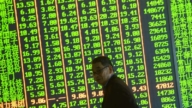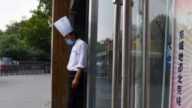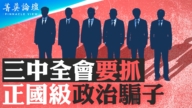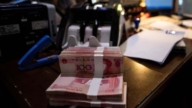【新唐人2012年7月16日訊】中國經濟增長減緩成為國際輿論焦點。中國今年第二季度GDP三年來首次「破八」。大陸有大學教授大聲疾呼「18大後能否啟動真正的改革,是經濟發展關鍵」,學者呼籲大陸經濟邁向真正的「市場機制」。也有學者指出,中國過去二十年的高速增長依賴的「低成本模式」已經結束,中國經濟進入了大拐點。
中國的第二季度GDP增長率官方公布為7.6,這是三年來首次低於百分之八的數字。著有《大拐點》等著作的經濟評論家袁劍指出,他對「破八」毫不感到意外。他說,貨幣政策恢復正常以後,中國的經濟增長速度一定是一個下降的過程。
袁劍:「09年以後,基本上是刺激政策,信貸泡沫導致的,重新出現的所謂高速增長。本來中國潛在增長率在2007年已經在下降了。國際形勢,包括中國內需增長,到07年都有問題了。08年有一個刺激政策,把它帶動了兩三年。現在貨幣恢復正常,下降基本是非常正常。」
美國《外交政策》(Foreign Policy)雜誌發表《中國經濟災難的五個跡象》文章。文章中指出,各種數據顯示,中國廣為傳頌的經濟增長引擎已經熄火,包括企業借款減少;製造業產出下降;利率意外削減;進口增長停滯;GDP增速預期已經下調。
袁劍則指出,中國經濟高速增長依賴的「低成本模式」已經終結,這意味著中國經濟高速列車必然剎車。所謂「低成本模式」就是剝削廉價勞動力,剝奪公民社會福利,並破壞環境,貽害子孫後代的方式,換取暫時的高速經濟增長。
袁劍:「中國政府參與經濟活動非常多,非常廣泛和深刻的捲入了經濟增長的過程。政府在這當中起到的作用其實就是壓低成本的作用。壓低各種各樣的成本,環境成本,勞動力成本,甚至免費送地,這樣的情況壓低了中國製造業的成本,這些成本不會無緣無故的消失,他被轉移了。」
但是社會在覺醒,每年數萬起「群體事件」就是對這種低成本模式的反彈,中國高速經濟增長也走向終結。
「復旦大學」財務金融系教授孔愛國對《中央社》表示,中國經濟問題的根源乃是政治體制。他說,「政治格局決定政府行為,政府行為不改變,真正的市場經濟機制難啟動。」他認為,央企、國企一定要改革,分散股權走向民營化,「不能甚麼重大建設都獨厚央企、國企」,政府不退出來,央企、國企就不會退,民間力量進不來,資金無處投放,大陸經濟會變成一潭死水、惡性循環。
「中國清華大學」經濟管理學院教授魏傑表示,中國必須立足於經濟增速不能掉到7%以下,否則會引發失業等「社會深層次問題」。袁劍認為,經濟放緩本身是一個正常現象。中國的問題在於,社會建設,福利制度等社會基礎的薄弱,和政治制度的薄弱所導致的社會承受能力脆弱。他說,經濟放緩可能出現各種各樣難以預料的後果。
總部位於倫敦的研究公司「凱投宏觀」(Capital Economics)在上次經濟低迷(也就是2008年和2009年全球金融危機)期間,創建了自己的中國GDP指數。這個指數顯示,中國經濟今年第一季度的增速在7.6%左右,比官方的GDP數據低0.5個百分點。可以推測,第二季度百分之7.6的GDP數字也是含有水分的。
採訪/編輯/秦雪 後製/鍾元
China’s GDP growth falls below 8%, indicating the end of
“cost reduction mode” in stimulating the economy
Recently, China’s GDP growth slow down became the central
topic of global media.
In the second quarter of 2012, China’s GDP growth fell
below 8% for the first time in three years.
Some mainland professors claimed that the key for keeping
economic development depends on whether the 18th national congress initializes a true reform.
Some scholars also called for turning China’s economic
system into a real market one.
Another scholar pointed out that, China’s “cost reduction
mode” which generated the high GDP growth in the past 20 years had reached its end;
China’s economy has encountered a big turning point.
The CCP authority announced officially that China’s GDP
growth in the second season of 2012 is 7.6%,
which for the first time fell below 8% in three years.
Yuan Jian economic commentator and the author of “A Big
Turning Point” said that this was nothing surprising.
Yuan remarked that, as the monetary policy restored to
normal China’s economic growth would inevitably drop.
Yuan Jian: ”After 2009, the high economic growth was basically
induced by stimulation policies and bubble economy from loans.
In fact China’s potential economic growth had been
dropping since 2007.
At that time, the global situation and low domestic demand
caused trouble to China’s economy.
In 2008 the authority introduced a stimulation policy
and it worked for two to three years.
Currently as the monetary policy is restored, the GDP growth
Slow down can be expected.”
US magazine Foreign Policy published an article called
“Five signs of the coming economic disaster in China”.
The article said that, according to the statistics, burnout
of China’s well-praised economic growth engine had occurred.
The signs included loan reduction from companies, decreasing
output of manufacturing industry,
unexpected cut of interest rates, cease of export growth and
drop of expected GDP growth.
Yuan Jian pointed out that the “cost reduction mode”
which China relied on to keep a high economic growth,
has reached its end; hence the “high-speed train” of
China’s economy had to decelerate.
The so-called “cost reduction mode” refers to generating a
temporary economic growth by exploiting labor costs,
depriving civilians of their social benefits and
destroying the environment.
Yuan Jian: “Involved in numerous economic activities,
the Chinese Communist Party (CCP) government had
a wide and huge effect on the process of economic growth.
In fact the CCP played a role of reducing various kinds of costs
such as environmental cost, labor cost and giving out free land.
These moves reduced the cost of manufacturing industry
in China.
However, the reduced cost did not disappear;
they were only shifted.”
However, Chinese civilians are gradually awakening.
They reacted to the “cost reduction mode” with massive
protests which happened tens of thousands times a year,
bringing an end to China’s high GDP growth.
Professor of Finance Department at Fudan University,
Kong Aiguo told the Central News Agency that
the problems of China’s economy were rooted in
the political regime.
Kong said, “Governmental behavior is determined
by its political system.
Without changing governmental behaviors,
it’s impossible to develop a true market economy”.
Kong believes that the state-owned companies must
reform and transfer equities to civilians.
“We can’t only give benefit to state-owned companies
in every important project” Kong said.
“Civil investments are all blocked with state-owned
companies staying in the way.
China’s economy will be trapped into a vicious cycle
towards a stagnant form.”
Professor of Economic College at Tshinghua University
Wei Jie once claimed that
China’s GDP growth could not fall below 7%,
otherwise many fundamental social problems
such as unemployment growth would be induced.
Yuan Jian remarked that GDP growth slowdown was
a natural phenomenon itself.
The real problem lay in malfunctions of social construction,
welfare and other fundamental systems.
China’s frail political regime also led to a low endurance
capacity of the whole Chinese society.
Yuan believes that GDP growth slow down might result
in various unexpected problems.
UK-based company Capital Economics created
its own index of China GDP between 2008 and 2009.
According to the index, China’s economy increased by 7.6%
in the first season of 2012, 0.5% lower than CCP official data.
It is expected that the officially announced 7.6% GDP
growth in the second season is also an exaggerated number.




























